Best Auditing and Assurance Report 2022
VerifiedAdded on 2022/08/28
|11
|2258
|14
AI Summary
Contribute Materials
Your contribution can guide someone’s learning journey. Share your
documents today.
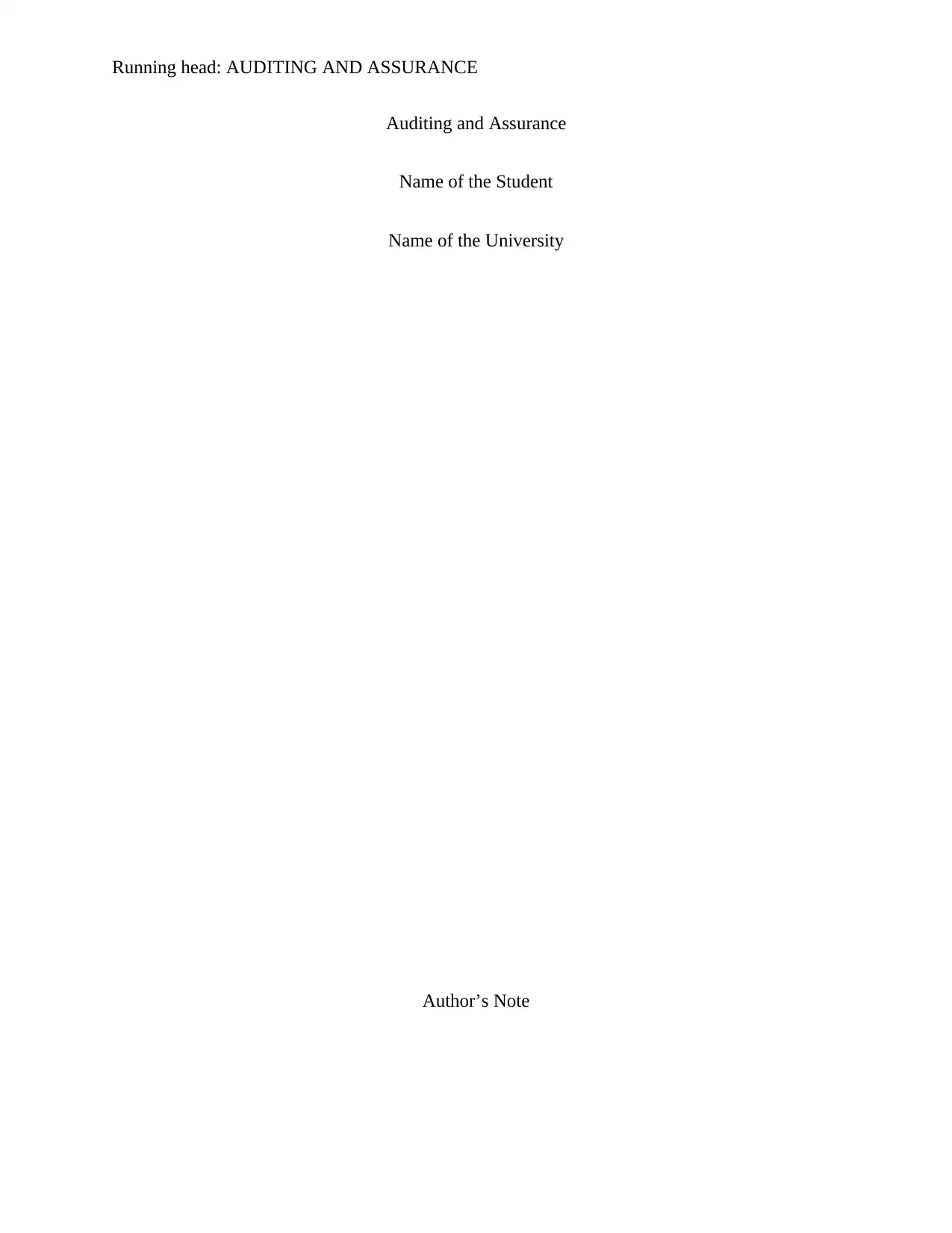
Running head: AUDITING AND ASSURANCE
Auditing and Assurance
Name of the Student
Name of the University
Author’s Note
Auditing and Assurance
Name of the Student
Name of the University
Author’s Note
Secure Best Marks with AI Grader
Need help grading? Try our AI Grader for instant feedback on your assignments.
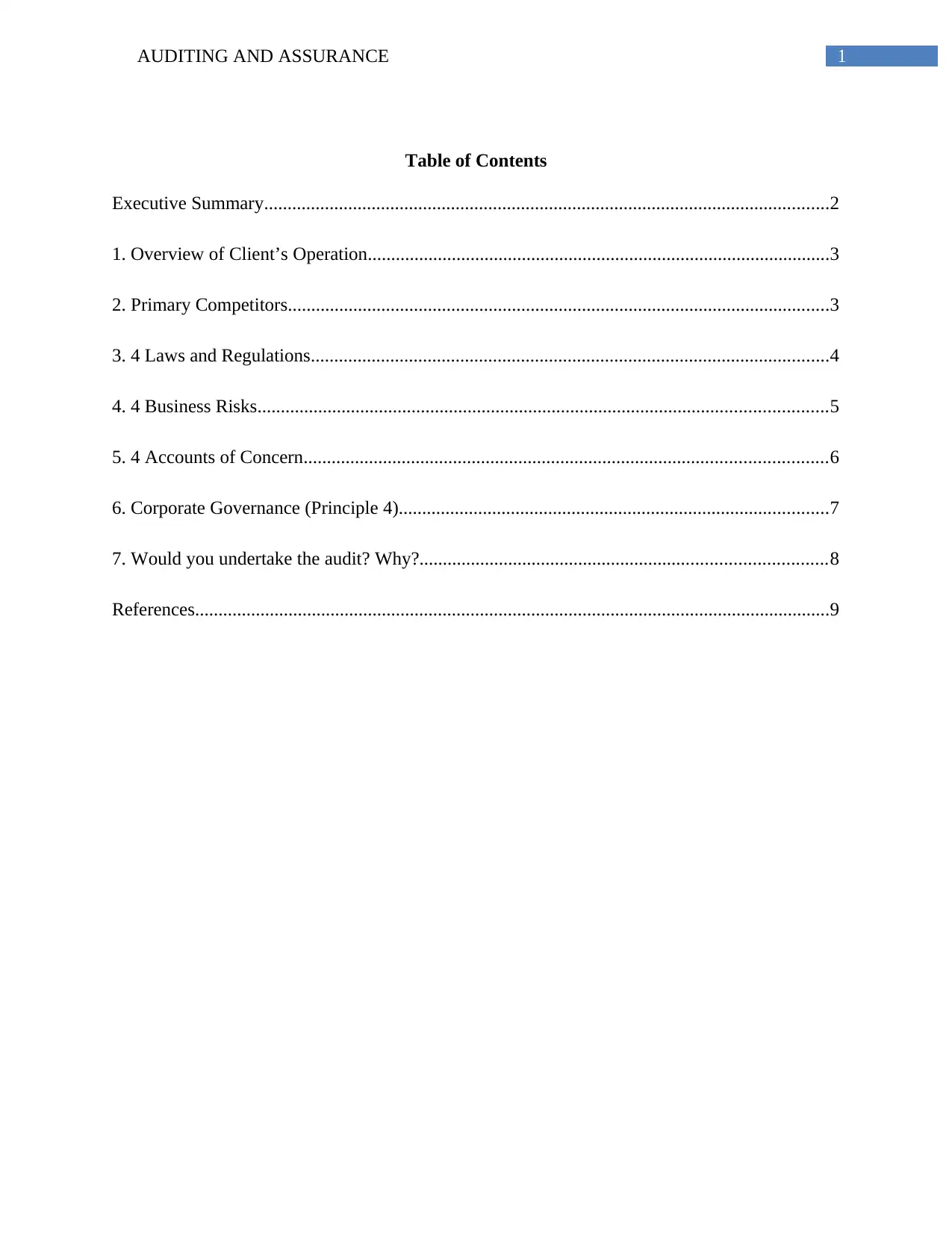
1AUDITING AND ASSURANCE
Table of Contents
Executive Summary.........................................................................................................................2
1. Overview of Client’s Operation...................................................................................................3
2. Primary Competitors....................................................................................................................3
3. 4 Laws and Regulations...............................................................................................................4
4. 4 Business Risks..........................................................................................................................5
5. 4 Accounts of Concern................................................................................................................6
6. Corporate Governance (Principle 4)............................................................................................7
7. Would you undertake the audit? Why?.......................................................................................8
References........................................................................................................................................9
Table of Contents
Executive Summary.........................................................................................................................2
1. Overview of Client’s Operation...................................................................................................3
2. Primary Competitors....................................................................................................................3
3. 4 Laws and Regulations...............................................................................................................4
4. 4 Business Risks..........................................................................................................................5
5. 4 Accounts of Concern................................................................................................................6
6. Corporate Governance (Principle 4)............................................................................................7
7. Would you undertake the audit? Why?.......................................................................................8
References........................................................................................................................................9
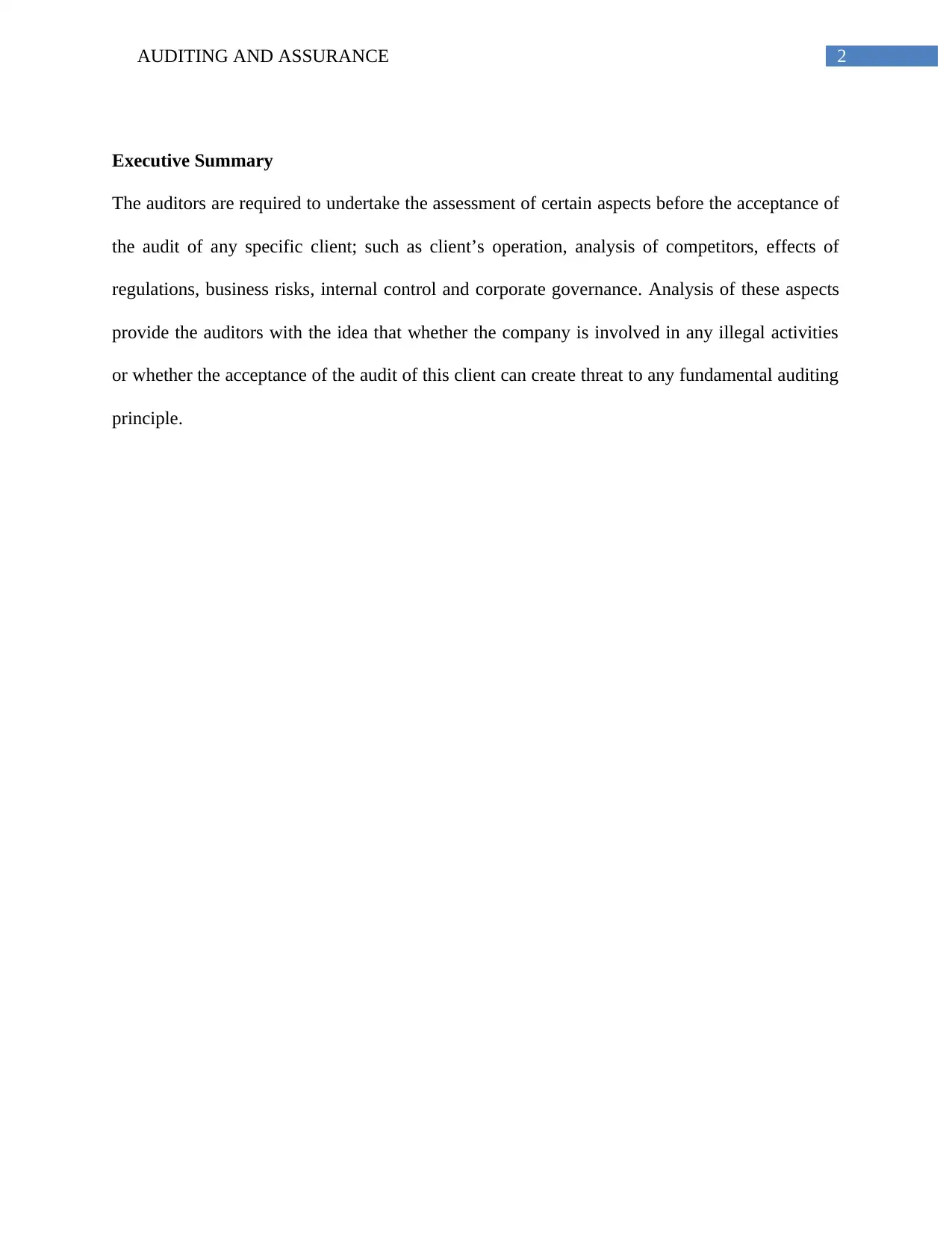
2AUDITING AND ASSURANCE
Executive Summary
The auditors are required to undertake the assessment of certain aspects before the acceptance of
the audit of any specific client; such as client’s operation, analysis of competitors, effects of
regulations, business risks, internal control and corporate governance. Analysis of these aspects
provide the auditors with the idea that whether the company is involved in any illegal activities
or whether the acceptance of the audit of this client can create threat to any fundamental auditing
principle.
Executive Summary
The auditors are required to undertake the assessment of certain aspects before the acceptance of
the audit of any specific client; such as client’s operation, analysis of competitors, effects of
regulations, business risks, internal control and corporate governance. Analysis of these aspects
provide the auditors with the idea that whether the company is involved in any illegal activities
or whether the acceptance of the audit of this client can create threat to any fundamental auditing
principle.
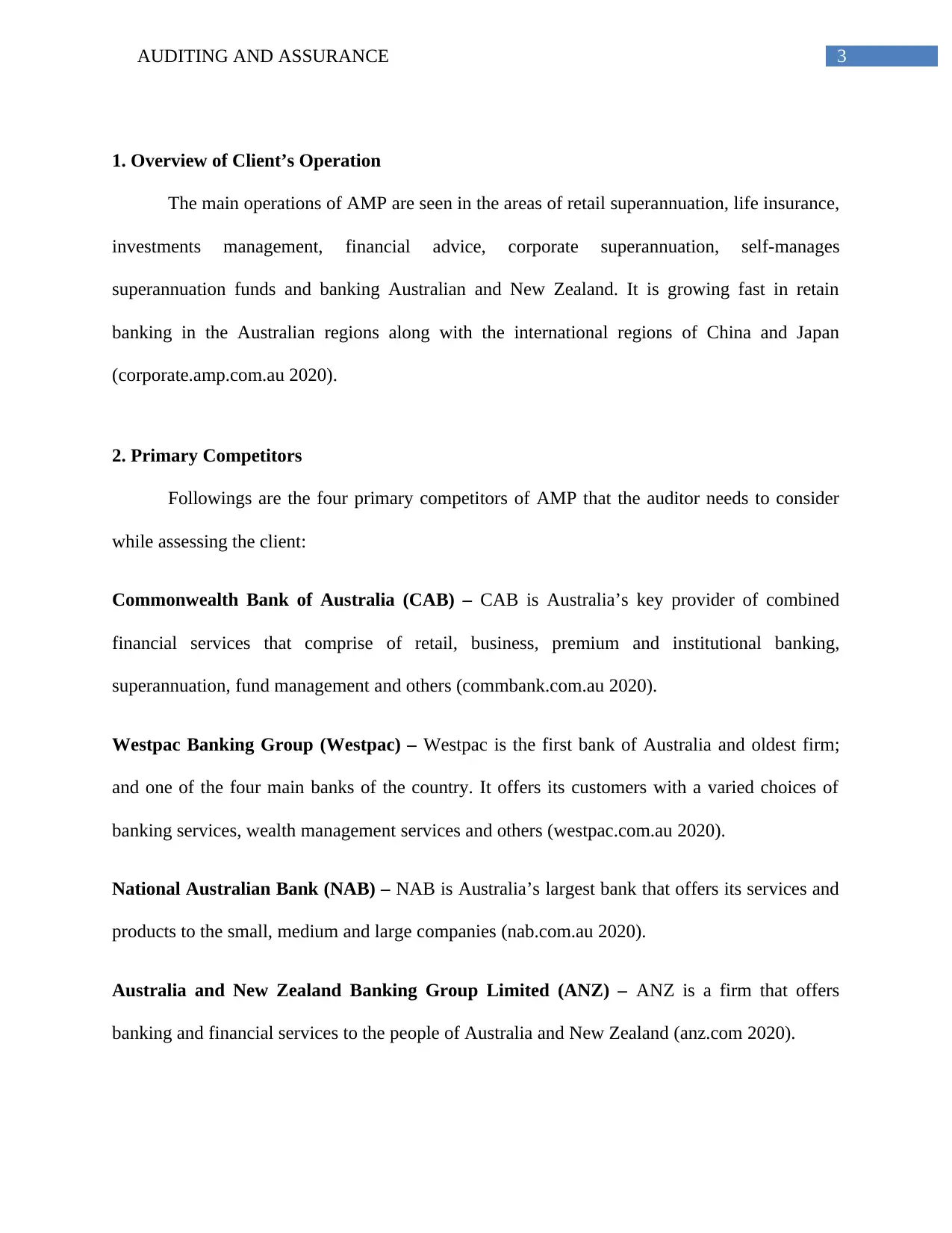
3AUDITING AND ASSURANCE
1. Overview of Client’s Operation
The main operations of AMP are seen in the areas of retail superannuation, life insurance,
investments management, financial advice, corporate superannuation, self-manages
superannuation funds and banking Australian and New Zealand. It is growing fast in retain
banking in the Australian regions along with the international regions of China and Japan
(corporate.amp.com.au 2020).
2. Primary Competitors
Followings are the four primary competitors of AMP that the auditor needs to consider
while assessing the client:
Commonwealth Bank of Australia (CAB) – CAB is Australia’s key provider of combined
financial services that comprise of retail, business, premium and institutional banking,
superannuation, fund management and others (commbank.com.au 2020).
Westpac Banking Group (Westpac) – Westpac is the first bank of Australia and oldest firm;
and one of the four main banks of the country. It offers its customers with a varied choices of
banking services, wealth management services and others (westpac.com.au 2020).
National Australian Bank (NAB) – NAB is Australia’s largest bank that offers its services and
products to the small, medium and large companies (nab.com.au 2020).
Australia and New Zealand Banking Group Limited (ANZ) – ANZ is a firm that offers
banking and financial services to the people of Australia and New Zealand (anz.com 2020).
1. Overview of Client’s Operation
The main operations of AMP are seen in the areas of retail superannuation, life insurance,
investments management, financial advice, corporate superannuation, self-manages
superannuation funds and banking Australian and New Zealand. It is growing fast in retain
banking in the Australian regions along with the international regions of China and Japan
(corporate.amp.com.au 2020).
2. Primary Competitors
Followings are the four primary competitors of AMP that the auditor needs to consider
while assessing the client:
Commonwealth Bank of Australia (CAB) – CAB is Australia’s key provider of combined
financial services that comprise of retail, business, premium and institutional banking,
superannuation, fund management and others (commbank.com.au 2020).
Westpac Banking Group (Westpac) – Westpac is the first bank of Australia and oldest firm;
and one of the four main banks of the country. It offers its customers with a varied choices of
banking services, wealth management services and others (westpac.com.au 2020).
National Australian Bank (NAB) – NAB is Australia’s largest bank that offers its services and
products to the small, medium and large companies (nab.com.au 2020).
Australia and New Zealand Banking Group Limited (ANZ) – ANZ is a firm that offers
banking and financial services to the people of Australia and New Zealand (anz.com 2020).
Secure Best Marks with AI Grader
Need help grading? Try our AI Grader for instant feedback on your assignments.
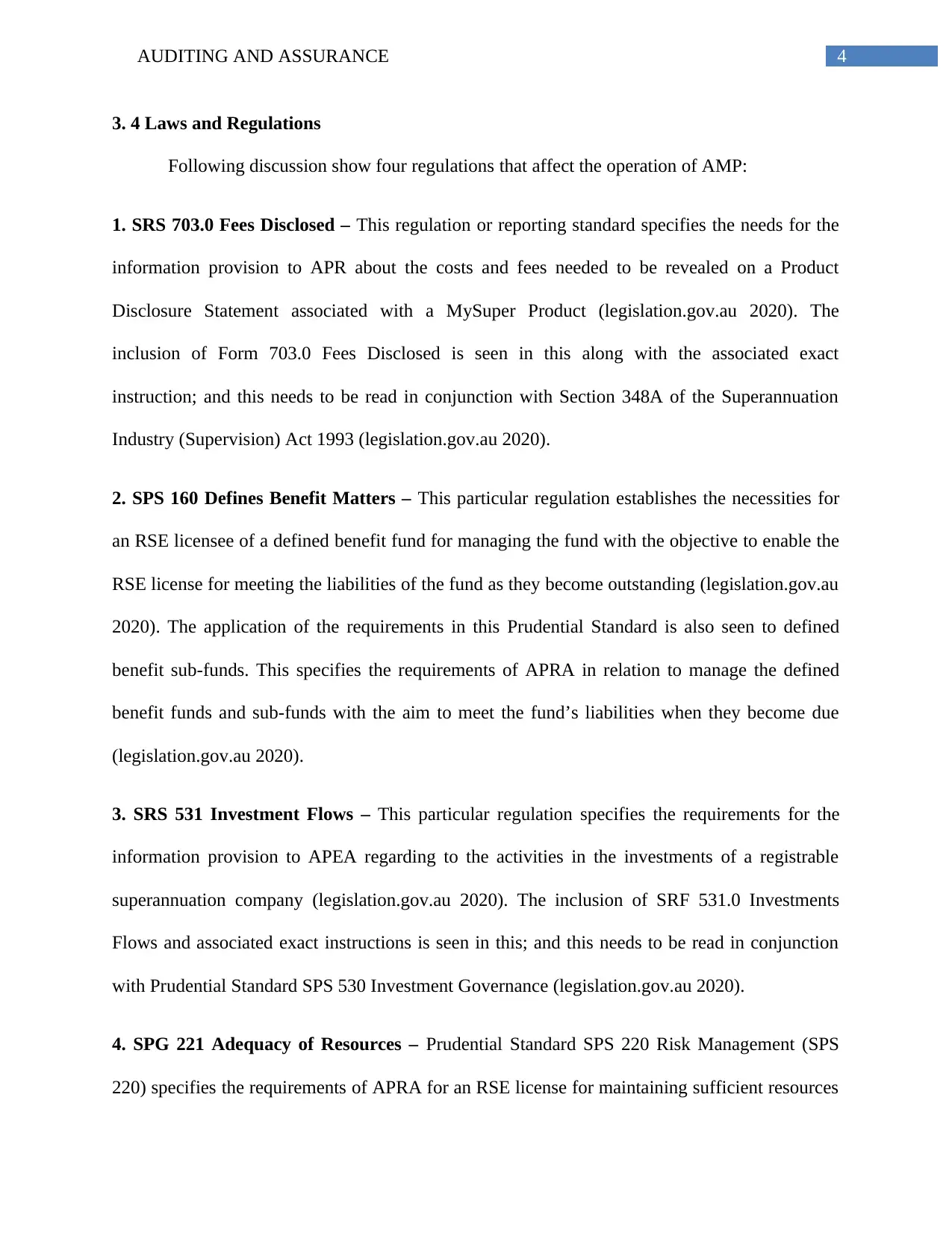
4AUDITING AND ASSURANCE
3. 4 Laws and Regulations
Following discussion show four regulations that affect the operation of AMP:
1. SRS 703.0 Fees Disclosed – This regulation or reporting standard specifies the needs for the
information provision to APR about the costs and fees needed to be revealed on a Product
Disclosure Statement associated with a MySuper Product (legislation.gov.au 2020). The
inclusion of Form 703.0 Fees Disclosed is seen in this along with the associated exact
instruction; and this needs to be read in conjunction with Section 348A of the Superannuation
Industry (Supervision) Act 1993 (legislation.gov.au 2020).
2. SPS 160 Defines Benefit Matters – This particular regulation establishes the necessities for
an RSE licensee of a defined benefit fund for managing the fund with the objective to enable the
RSE license for meeting the liabilities of the fund as they become outstanding (legislation.gov.au
2020). The application of the requirements in this Prudential Standard is also seen to defined
benefit sub-funds. This specifies the requirements of APRA in relation to manage the defined
benefit funds and sub-funds with the aim to meet the fund’s liabilities when they become due
(legislation.gov.au 2020).
3. SRS 531 Investment Flows – This particular regulation specifies the requirements for the
information provision to APEA regarding to the activities in the investments of a registrable
superannuation company (legislation.gov.au 2020). The inclusion of SRF 531.0 Investments
Flows and associated exact instructions is seen in this; and this needs to be read in conjunction
with Prudential Standard SPS 530 Investment Governance (legislation.gov.au 2020).
4. SPG 221 Adequacy of Resources – Prudential Standard SPS 220 Risk Management (SPS
220) specifies the requirements of APRA for an RSE license for maintaining sufficient resources
3. 4 Laws and Regulations
Following discussion show four regulations that affect the operation of AMP:
1. SRS 703.0 Fees Disclosed – This regulation or reporting standard specifies the needs for the
information provision to APR about the costs and fees needed to be revealed on a Product
Disclosure Statement associated with a MySuper Product (legislation.gov.au 2020). The
inclusion of Form 703.0 Fees Disclosed is seen in this along with the associated exact
instruction; and this needs to be read in conjunction with Section 348A of the Superannuation
Industry (Supervision) Act 1993 (legislation.gov.au 2020).
2. SPS 160 Defines Benefit Matters – This particular regulation establishes the necessities for
an RSE licensee of a defined benefit fund for managing the fund with the objective to enable the
RSE license for meeting the liabilities of the fund as they become outstanding (legislation.gov.au
2020). The application of the requirements in this Prudential Standard is also seen to defined
benefit sub-funds. This specifies the requirements of APRA in relation to manage the defined
benefit funds and sub-funds with the aim to meet the fund’s liabilities when they become due
(legislation.gov.au 2020).
3. SRS 531 Investment Flows – This particular regulation specifies the requirements for the
information provision to APEA regarding to the activities in the investments of a registrable
superannuation company (legislation.gov.au 2020). The inclusion of SRF 531.0 Investments
Flows and associated exact instructions is seen in this; and this needs to be read in conjunction
with Prudential Standard SPS 530 Investment Governance (legislation.gov.au 2020).
4. SPG 221 Adequacy of Resources – Prudential Standard SPS 220 Risk Management (SPS
220) specifies the requirements of APRA for an RSE license for maintaining sufficient resources
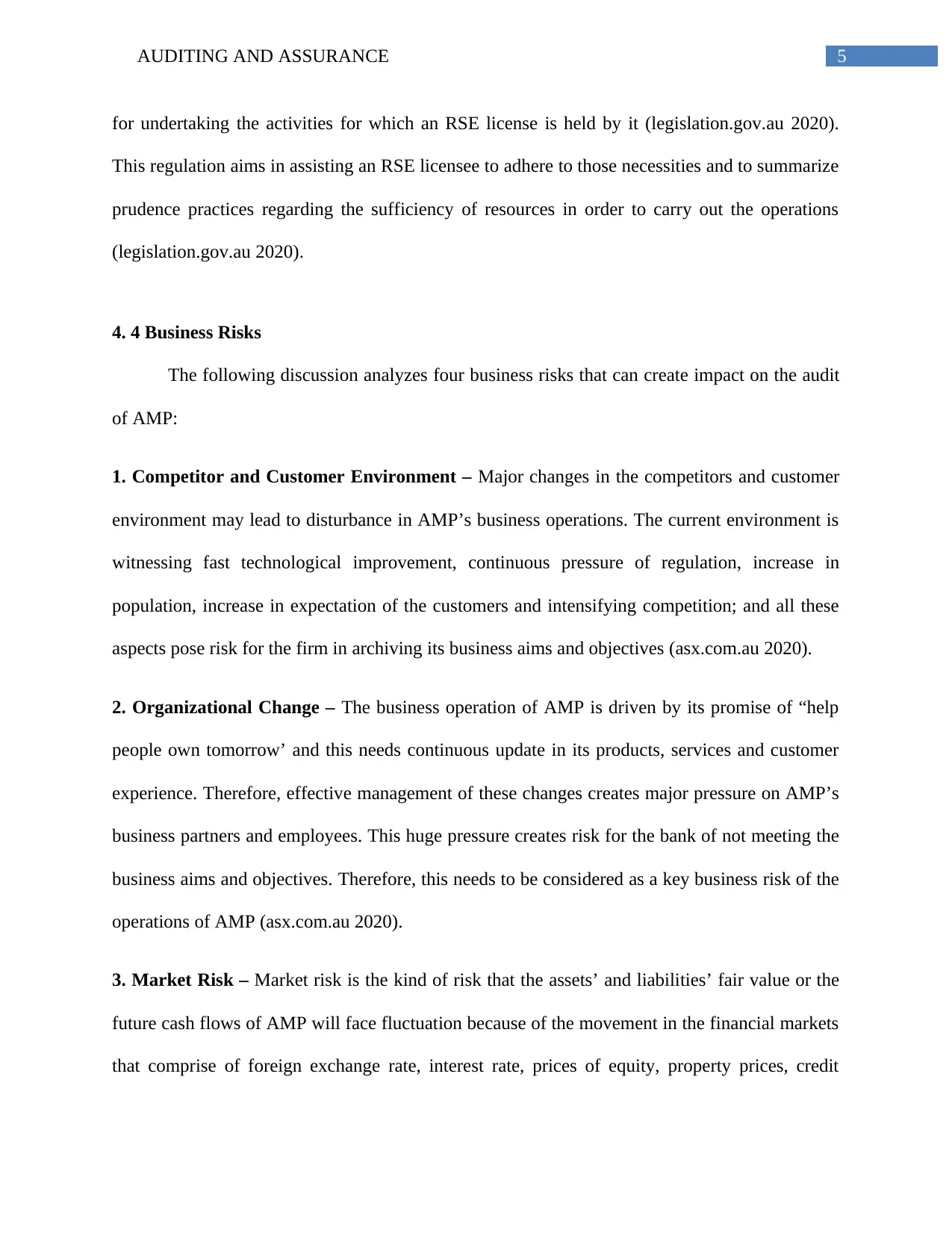
5AUDITING AND ASSURANCE
for undertaking the activities for which an RSE license is held by it (legislation.gov.au 2020).
This regulation aims in assisting an RSE licensee to adhere to those necessities and to summarize
prudence practices regarding the sufficiency of resources in order to carry out the operations
(legislation.gov.au 2020).
4. 4 Business Risks
The following discussion analyzes four business risks that can create impact on the audit
of AMP:
1. Competitor and Customer Environment – Major changes in the competitors and customer
environment may lead to disturbance in AMP’s business operations. The current environment is
witnessing fast technological improvement, continuous pressure of regulation, increase in
population, increase in expectation of the customers and intensifying competition; and all these
aspects pose risk for the firm in archiving its business aims and objectives (asx.com.au 2020).
2. Organizational Change – The business operation of AMP is driven by its promise of “help
people own tomorrow’ and this needs continuous update in its products, services and customer
experience. Therefore, effective management of these changes creates major pressure on AMP’s
business partners and employees. This huge pressure creates risk for the bank of not meeting the
business aims and objectives. Therefore, this needs to be considered as a key business risk of the
operations of AMP (asx.com.au 2020).
3. Market Risk – Market risk is the kind of risk that the assets’ and liabilities’ fair value or the
future cash flows of AMP will face fluctuation because of the movement in the financial markets
that comprise of foreign exchange rate, interest rate, prices of equity, property prices, credit
for undertaking the activities for which an RSE license is held by it (legislation.gov.au 2020).
This regulation aims in assisting an RSE licensee to adhere to those necessities and to summarize
prudence practices regarding the sufficiency of resources in order to carry out the operations
(legislation.gov.au 2020).
4. 4 Business Risks
The following discussion analyzes four business risks that can create impact on the audit
of AMP:
1. Competitor and Customer Environment – Major changes in the competitors and customer
environment may lead to disturbance in AMP’s business operations. The current environment is
witnessing fast technological improvement, continuous pressure of regulation, increase in
population, increase in expectation of the customers and intensifying competition; and all these
aspects pose risk for the firm in archiving its business aims and objectives (asx.com.au 2020).
2. Organizational Change – The business operation of AMP is driven by its promise of “help
people own tomorrow’ and this needs continuous update in its products, services and customer
experience. Therefore, effective management of these changes creates major pressure on AMP’s
business partners and employees. This huge pressure creates risk for the bank of not meeting the
business aims and objectives. Therefore, this needs to be considered as a key business risk of the
operations of AMP (asx.com.au 2020).
3. Market Risk – Market risk is the kind of risk that the assets’ and liabilities’ fair value or the
future cash flows of AMP will face fluctuation because of the movement in the financial markets
that comprise of foreign exchange rate, interest rate, prices of equity, property prices, credit
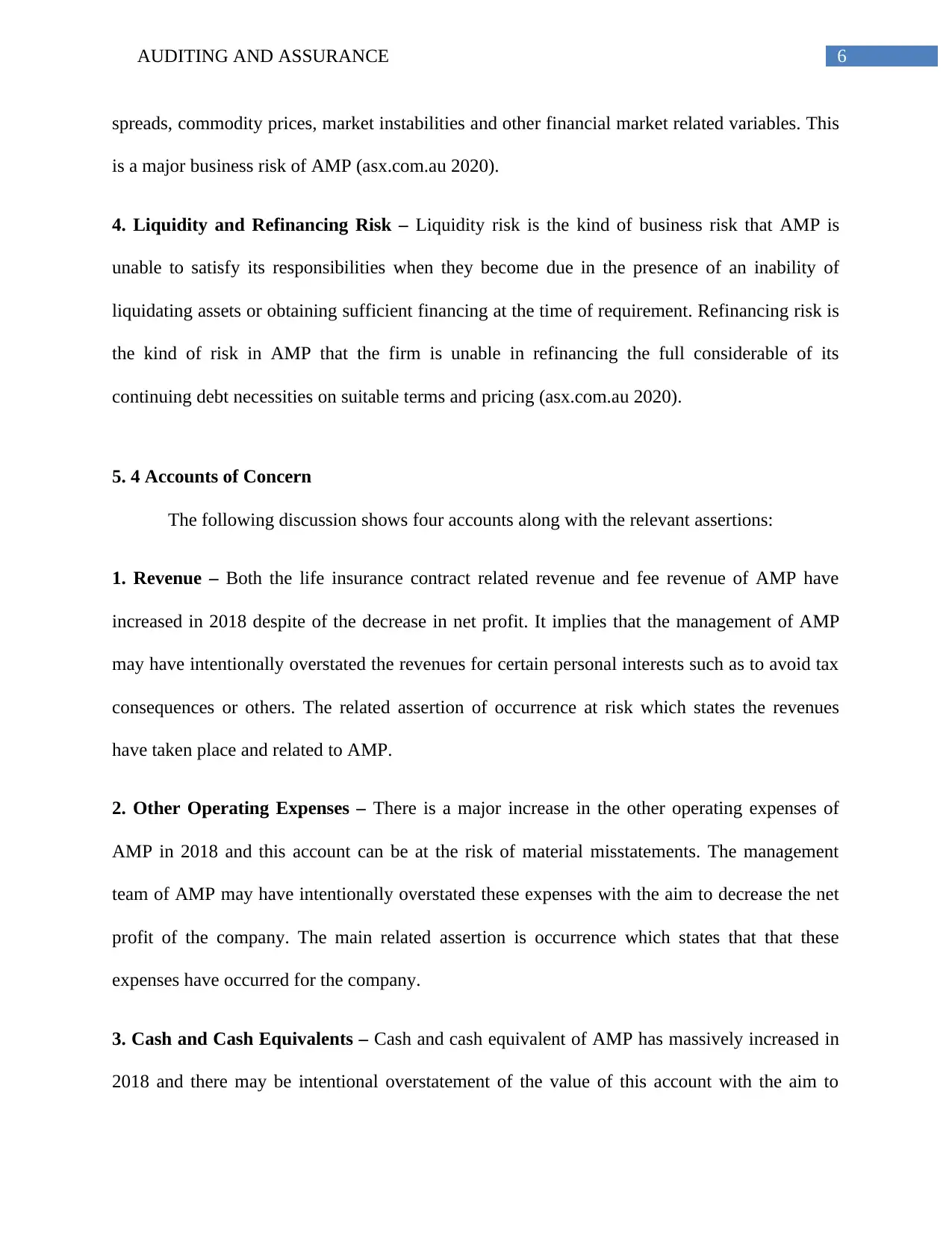
6AUDITING AND ASSURANCE
spreads, commodity prices, market instabilities and other financial market related variables. This
is a major business risk of AMP (asx.com.au 2020).
4. Liquidity and Refinancing Risk – Liquidity risk is the kind of business risk that AMP is
unable to satisfy its responsibilities when they become due in the presence of an inability of
liquidating assets or obtaining sufficient financing at the time of requirement. Refinancing risk is
the kind of risk in AMP that the firm is unable in refinancing the full considerable of its
continuing debt necessities on suitable terms and pricing (asx.com.au 2020).
5. 4 Accounts of Concern
The following discussion shows four accounts along with the relevant assertions:
1. Revenue – Both the life insurance contract related revenue and fee revenue of AMP have
increased in 2018 despite of the decrease in net profit. It implies that the management of AMP
may have intentionally overstated the revenues for certain personal interests such as to avoid tax
consequences or others. The related assertion of occurrence at risk which states the revenues
have taken place and related to AMP.
2. Other Operating Expenses – There is a major increase in the other operating expenses of
AMP in 2018 and this account can be at the risk of material misstatements. The management
team of AMP may have intentionally overstated these expenses with the aim to decrease the net
profit of the company. The main related assertion is occurrence which states that that these
expenses have occurred for the company.
3. Cash and Cash Equivalents – Cash and cash equivalent of AMP has massively increased in
2018 and there may be intentional overstatement of the value of this account with the aim to
spreads, commodity prices, market instabilities and other financial market related variables. This
is a major business risk of AMP (asx.com.au 2020).
4. Liquidity and Refinancing Risk – Liquidity risk is the kind of business risk that AMP is
unable to satisfy its responsibilities when they become due in the presence of an inability of
liquidating assets or obtaining sufficient financing at the time of requirement. Refinancing risk is
the kind of risk in AMP that the firm is unable in refinancing the full considerable of its
continuing debt necessities on suitable terms and pricing (asx.com.au 2020).
5. 4 Accounts of Concern
The following discussion shows four accounts along with the relevant assertions:
1. Revenue – Both the life insurance contract related revenue and fee revenue of AMP have
increased in 2018 despite of the decrease in net profit. It implies that the management of AMP
may have intentionally overstated the revenues for certain personal interests such as to avoid tax
consequences or others. The related assertion of occurrence at risk which states the revenues
have taken place and related to AMP.
2. Other Operating Expenses – There is a major increase in the other operating expenses of
AMP in 2018 and this account can be at the risk of material misstatements. The management
team of AMP may have intentionally overstated these expenses with the aim to decrease the net
profit of the company. The main related assertion is occurrence which states that that these
expenses have occurred for the company.
3. Cash and Cash Equivalents – Cash and cash equivalent of AMP has massively increased in
2018 and there may be intentional overstatement of the value of this account with the aim to
Paraphrase This Document
Need a fresh take? Get an instant paraphrase of this document with our AI Paraphraser
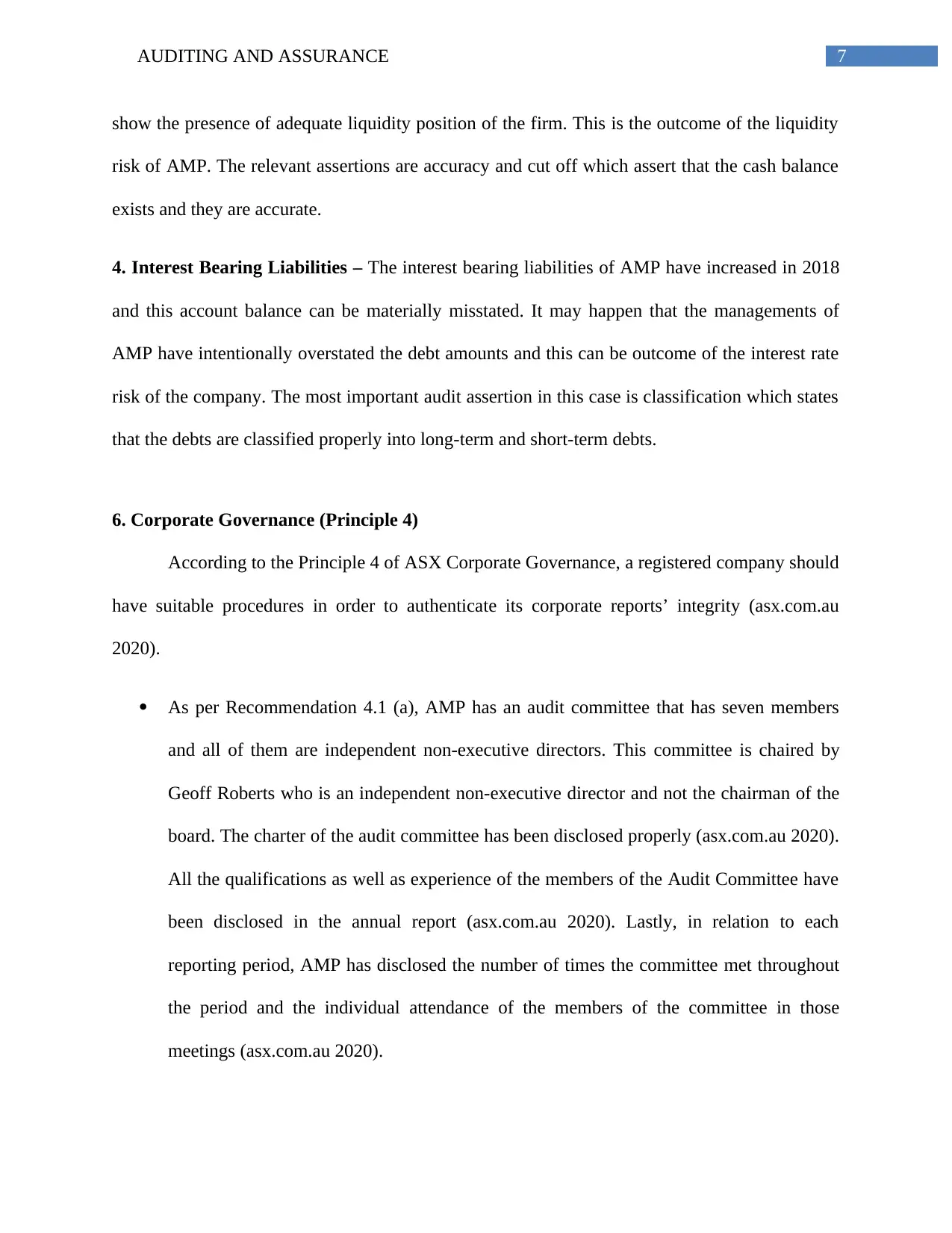
7AUDITING AND ASSURANCE
show the presence of adequate liquidity position of the firm. This is the outcome of the liquidity
risk of AMP. The relevant assertions are accuracy and cut off which assert that the cash balance
exists and they are accurate.
4. Interest Bearing Liabilities – The interest bearing liabilities of AMP have increased in 2018
and this account balance can be materially misstated. It may happen that the managements of
AMP have intentionally overstated the debt amounts and this can be outcome of the interest rate
risk of the company. The most important audit assertion in this case is classification which states
that the debts are classified properly into long-term and short-term debts.
6. Corporate Governance (Principle 4)
According to the Principle 4 of ASX Corporate Governance, a registered company should
have suitable procedures in order to authenticate its corporate reports’ integrity (asx.com.au
2020).
As per Recommendation 4.1 (a), AMP has an audit committee that has seven members
and all of them are independent non-executive directors. This committee is chaired by
Geoff Roberts who is an independent non-executive director and not the chairman of the
board. The charter of the audit committee has been disclosed properly (asx.com.au 2020).
All the qualifications as well as experience of the members of the Audit Committee have
been disclosed in the annual report (asx.com.au 2020). Lastly, in relation to each
reporting period, AMP has disclosed the number of times the committee met throughout
the period and the individual attendance of the members of the committee in those
meetings (asx.com.au 2020).
show the presence of adequate liquidity position of the firm. This is the outcome of the liquidity
risk of AMP. The relevant assertions are accuracy and cut off which assert that the cash balance
exists and they are accurate.
4. Interest Bearing Liabilities – The interest bearing liabilities of AMP have increased in 2018
and this account balance can be materially misstated. It may happen that the managements of
AMP have intentionally overstated the debt amounts and this can be outcome of the interest rate
risk of the company. The most important audit assertion in this case is classification which states
that the debts are classified properly into long-term and short-term debts.
6. Corporate Governance (Principle 4)
According to the Principle 4 of ASX Corporate Governance, a registered company should
have suitable procedures in order to authenticate its corporate reports’ integrity (asx.com.au
2020).
As per Recommendation 4.1 (a), AMP has an audit committee that has seven members
and all of them are independent non-executive directors. This committee is chaired by
Geoff Roberts who is an independent non-executive director and not the chairman of the
board. The charter of the audit committee has been disclosed properly (asx.com.au 2020).
All the qualifications as well as experience of the members of the Audit Committee have
been disclosed in the annual report (asx.com.au 2020). Lastly, in relation to each
reporting period, AMP has disclosed the number of times the committee met throughout
the period and the individual attendance of the members of the committee in those
meetings (asx.com.au 2020).
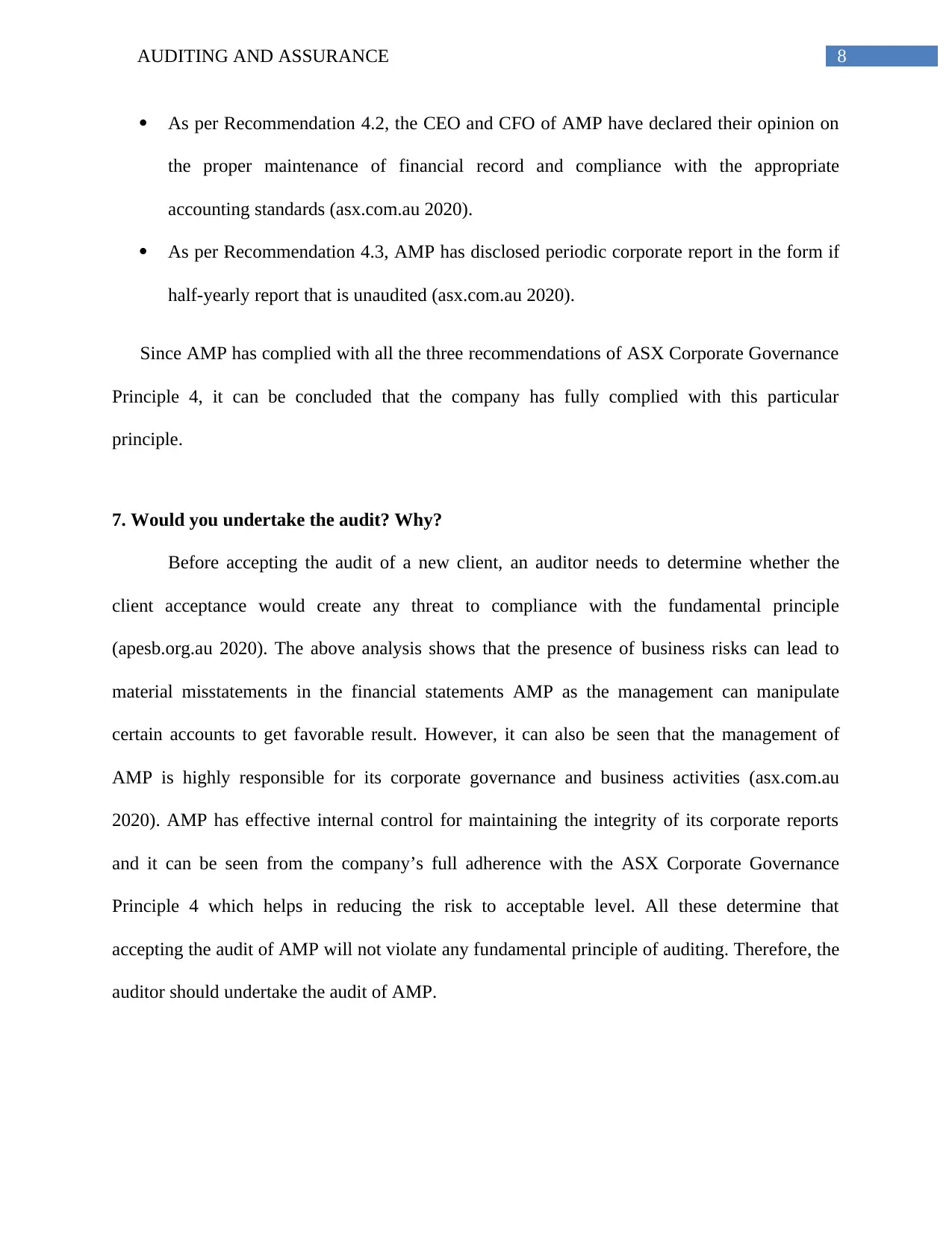
8AUDITING AND ASSURANCE
As per Recommendation 4.2, the CEO and CFO of AMP have declared their opinion on
the proper maintenance of financial record and compliance with the appropriate
accounting standards (asx.com.au 2020).
As per Recommendation 4.3, AMP has disclosed periodic corporate report in the form if
half-yearly report that is unaudited (asx.com.au 2020).
Since AMP has complied with all the three recommendations of ASX Corporate Governance
Principle 4, it can be concluded that the company has fully complied with this particular
principle.
7. Would you undertake the audit? Why?
Before accepting the audit of a new client, an auditor needs to determine whether the
client acceptance would create any threat to compliance with the fundamental principle
(apesb.org.au 2020). The above analysis shows that the presence of business risks can lead to
material misstatements in the financial statements AMP as the management can manipulate
certain accounts to get favorable result. However, it can also be seen that the management of
AMP is highly responsible for its corporate governance and business activities (asx.com.au
2020). AMP has effective internal control for maintaining the integrity of its corporate reports
and it can be seen from the company’s full adherence with the ASX Corporate Governance
Principle 4 which helps in reducing the risk to acceptable level. All these determine that
accepting the audit of AMP will not violate any fundamental principle of auditing. Therefore, the
auditor should undertake the audit of AMP.
As per Recommendation 4.2, the CEO and CFO of AMP have declared their opinion on
the proper maintenance of financial record and compliance with the appropriate
accounting standards (asx.com.au 2020).
As per Recommendation 4.3, AMP has disclosed periodic corporate report in the form if
half-yearly report that is unaudited (asx.com.au 2020).
Since AMP has complied with all the three recommendations of ASX Corporate Governance
Principle 4, it can be concluded that the company has fully complied with this particular
principle.
7. Would you undertake the audit? Why?
Before accepting the audit of a new client, an auditor needs to determine whether the
client acceptance would create any threat to compliance with the fundamental principle
(apesb.org.au 2020). The above analysis shows that the presence of business risks can lead to
material misstatements in the financial statements AMP as the management can manipulate
certain accounts to get favorable result. However, it can also be seen that the management of
AMP is highly responsible for its corporate governance and business activities (asx.com.au
2020). AMP has effective internal control for maintaining the integrity of its corporate reports
and it can be seen from the company’s full adherence with the ASX Corporate Governance
Principle 4 which helps in reducing the risk to acceptable level. All these determine that
accepting the audit of AMP will not violate any fundamental principle of auditing. Therefore, the
auditor should undertake the audit of AMP.
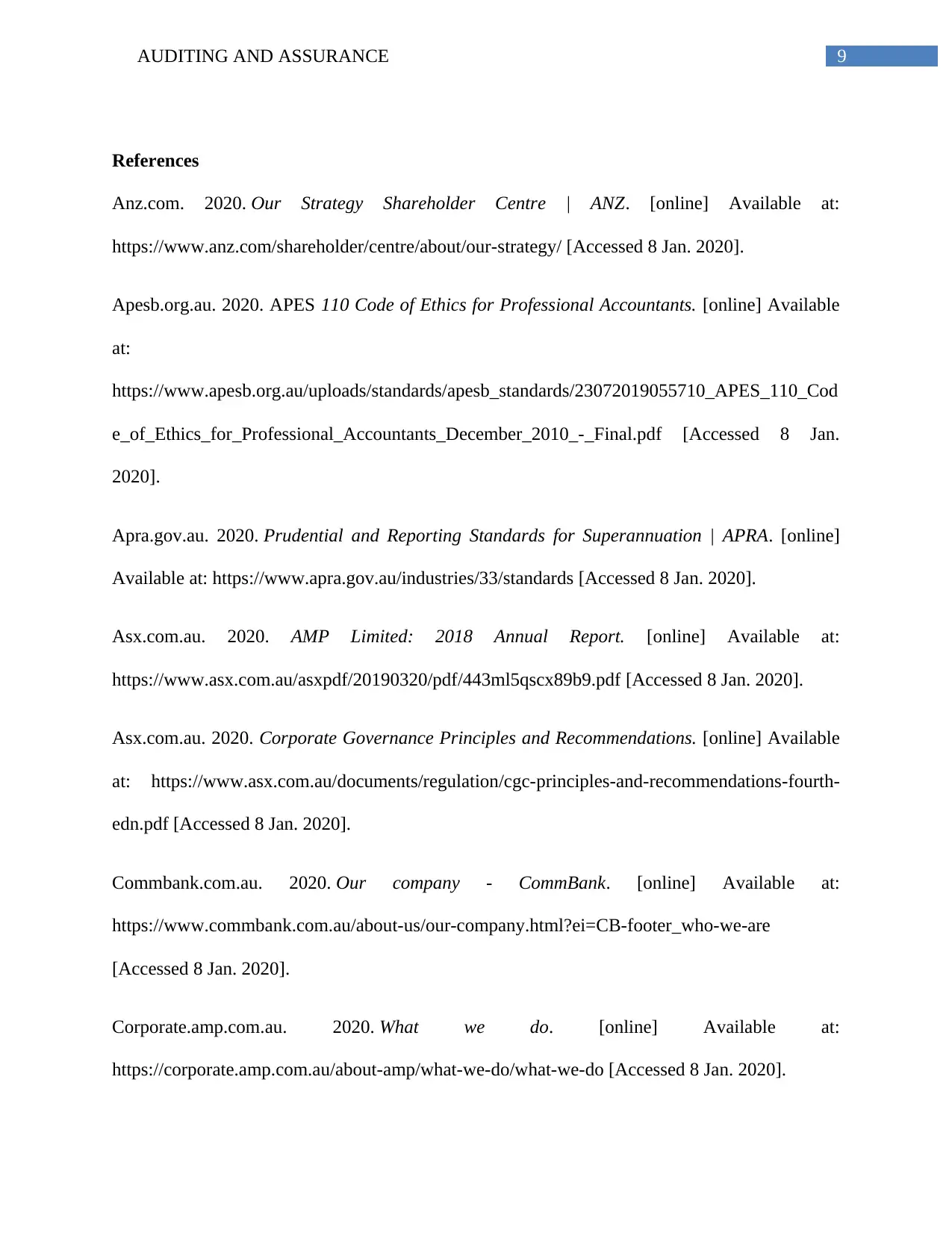
9AUDITING AND ASSURANCE
References
Anz.com. 2020. Our Strategy Shareholder Centre | ANZ. [online] Available at:
https://www.anz.com/shareholder/centre/about/our-strategy/ [Accessed 8 Jan. 2020].
Apesb.org.au. 2020. APES 110 Code of Ethics for Professional Accountants. [online] Available
at:
https://www.apesb.org.au/uploads/standards/apesb_standards/23072019055710_APES_110_Cod
e_of_Ethics_for_Professional_Accountants_December_2010_-_Final.pdf [Accessed 8 Jan.
2020].
Apra.gov.au. 2020. Prudential and Reporting Standards for Superannuation | APRA. [online]
Available at: https://www.apra.gov.au/industries/33/standards [Accessed 8 Jan. 2020].
Asx.com.au. 2020. AMP Limited: 2018 Annual Report. [online] Available at:
https://www.asx.com.au/asxpdf/20190320/pdf/443ml5qscx89b9.pdf [Accessed 8 Jan. 2020].
Asx.com.au. 2020. Corporate Governance Principles and Recommendations. [online] Available
at: https://www.asx.com.au/documents/regulation/cgc-principles-and-recommendations-fourth-
edn.pdf [Accessed 8 Jan. 2020].
Commbank.com.au. 2020. Our company - CommBank. [online] Available at:
https://www.commbank.com.au/about-us/our-company.html?ei=CB-footer_who-we-are
[Accessed 8 Jan. 2020].
Corporate.amp.com.au. 2020. What we do. [online] Available at:
https://corporate.amp.com.au/about-amp/what-we-do/what-we-do [Accessed 8 Jan. 2020].
References
Anz.com. 2020. Our Strategy Shareholder Centre | ANZ. [online] Available at:
https://www.anz.com/shareholder/centre/about/our-strategy/ [Accessed 8 Jan. 2020].
Apesb.org.au. 2020. APES 110 Code of Ethics for Professional Accountants. [online] Available
at:
https://www.apesb.org.au/uploads/standards/apesb_standards/23072019055710_APES_110_Cod
e_of_Ethics_for_Professional_Accountants_December_2010_-_Final.pdf [Accessed 8 Jan.
2020].
Apra.gov.au. 2020. Prudential and Reporting Standards for Superannuation | APRA. [online]
Available at: https://www.apra.gov.au/industries/33/standards [Accessed 8 Jan. 2020].
Asx.com.au. 2020. AMP Limited: 2018 Annual Report. [online] Available at:
https://www.asx.com.au/asxpdf/20190320/pdf/443ml5qscx89b9.pdf [Accessed 8 Jan. 2020].
Asx.com.au. 2020. Corporate Governance Principles and Recommendations. [online] Available
at: https://www.asx.com.au/documents/regulation/cgc-principles-and-recommendations-fourth-
edn.pdf [Accessed 8 Jan. 2020].
Commbank.com.au. 2020. Our company - CommBank. [online] Available at:
https://www.commbank.com.au/about-us/our-company.html?ei=CB-footer_who-we-are
[Accessed 8 Jan. 2020].
Corporate.amp.com.au. 2020. What we do. [online] Available at:
https://corporate.amp.com.au/about-amp/what-we-do/what-we-do [Accessed 8 Jan. 2020].
Secure Best Marks with AI Grader
Need help grading? Try our AI Grader for instant feedback on your assignments.
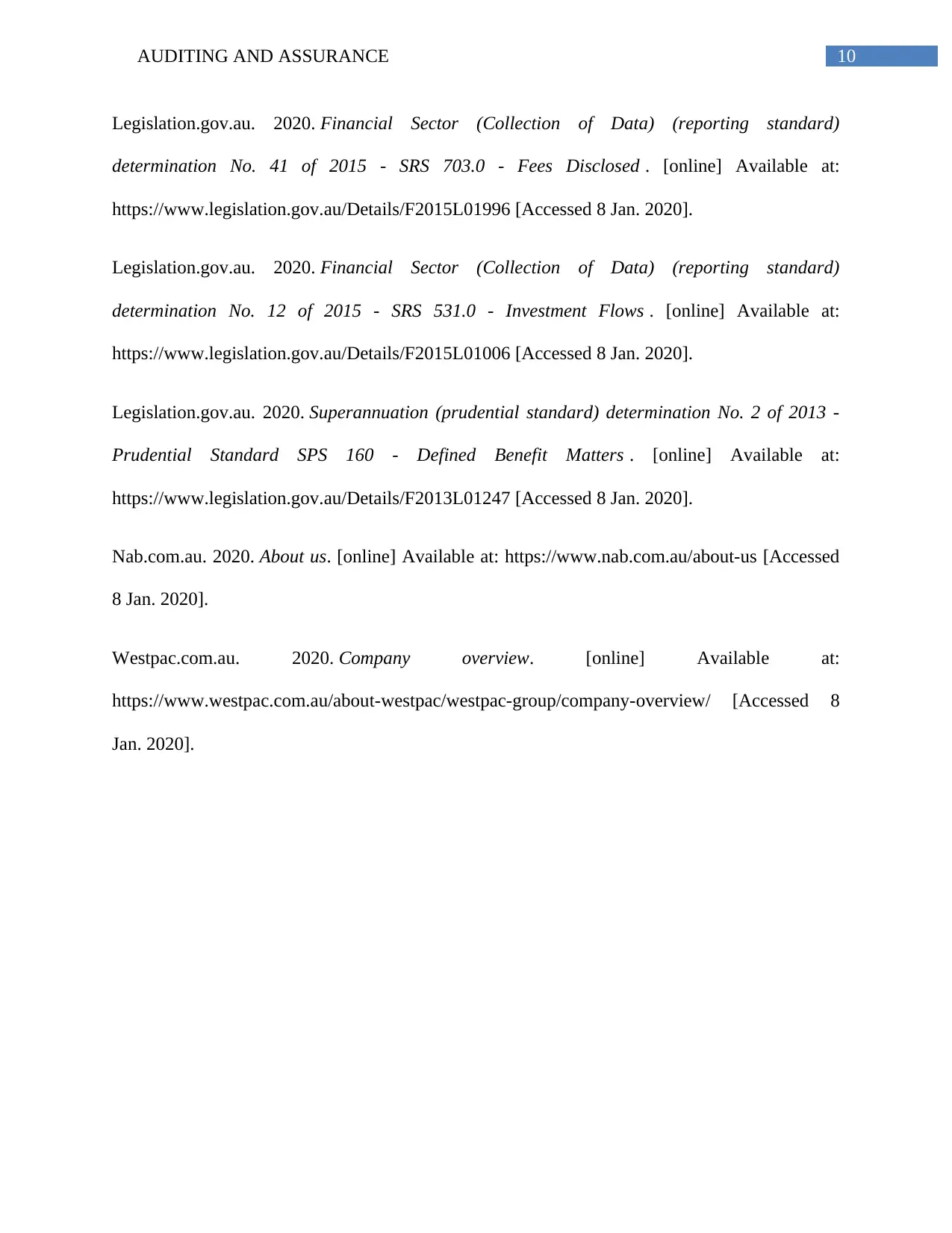
10AUDITING AND ASSURANCE
Legislation.gov.au. 2020. Financial Sector (Collection of Data) (reporting standard)
determination No. 41 of 2015 - SRS 703.0 - Fees Disclosed . [online] Available at:
https://www.legislation.gov.au/Details/F2015L01996 [Accessed 8 Jan. 2020].
Legislation.gov.au. 2020. Financial Sector (Collection of Data) (reporting standard)
determination No. 12 of 2015 - SRS 531.0 - Investment Flows . [online] Available at:
https://www.legislation.gov.au/Details/F2015L01006 [Accessed 8 Jan. 2020].
Legislation.gov.au. 2020. Superannuation (prudential standard) determination No. 2 of 2013 -
Prudential Standard SPS 160 - Defined Benefit Matters . [online] Available at:
https://www.legislation.gov.au/Details/F2013L01247 [Accessed 8 Jan. 2020].
Nab.com.au. 2020. About us. [online] Available at: https://www.nab.com.au/about-us [Accessed
8 Jan. 2020].
Westpac.com.au. 2020. Company overview. [online] Available at:
https://www.westpac.com.au/about-westpac/westpac-group/company-overview/ [Accessed 8
Jan. 2020].
Legislation.gov.au. 2020. Financial Sector (Collection of Data) (reporting standard)
determination No. 41 of 2015 - SRS 703.0 - Fees Disclosed . [online] Available at:
https://www.legislation.gov.au/Details/F2015L01996 [Accessed 8 Jan. 2020].
Legislation.gov.au. 2020. Financial Sector (Collection of Data) (reporting standard)
determination No. 12 of 2015 - SRS 531.0 - Investment Flows . [online] Available at:
https://www.legislation.gov.au/Details/F2015L01006 [Accessed 8 Jan. 2020].
Legislation.gov.au. 2020. Superannuation (prudential standard) determination No. 2 of 2013 -
Prudential Standard SPS 160 - Defined Benefit Matters . [online] Available at:
https://www.legislation.gov.au/Details/F2013L01247 [Accessed 8 Jan. 2020].
Nab.com.au. 2020. About us. [online] Available at: https://www.nab.com.au/about-us [Accessed
8 Jan. 2020].
Westpac.com.au. 2020. Company overview. [online] Available at:
https://www.westpac.com.au/about-westpac/westpac-group/company-overview/ [Accessed 8
Jan. 2020].
1 out of 11
Related Documents
Your All-in-One AI-Powered Toolkit for Academic Success.
+13062052269
info@desklib.com
Available 24*7 on WhatsApp / Email
![[object Object]](/_next/static/media/star-bottom.7253800d.svg)
Unlock your academic potential
© 2024 | Zucol Services PVT LTD | All rights reserved.





